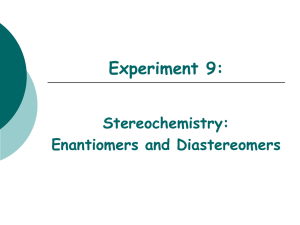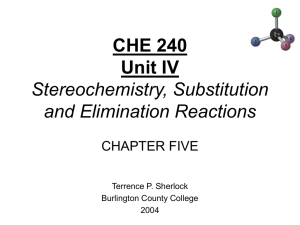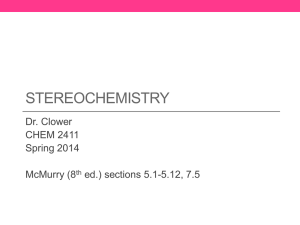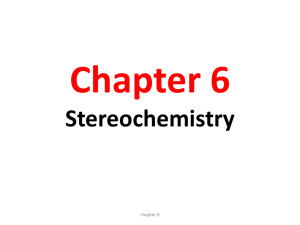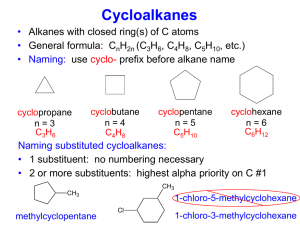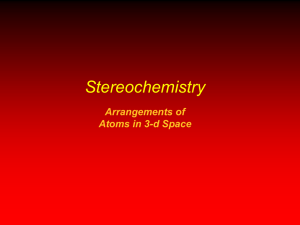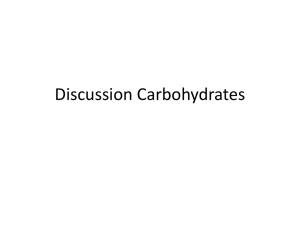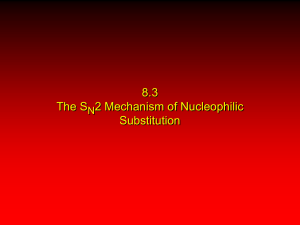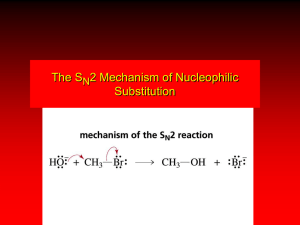Project Overview - Department of Chemistry and Biochemistry
advertisement
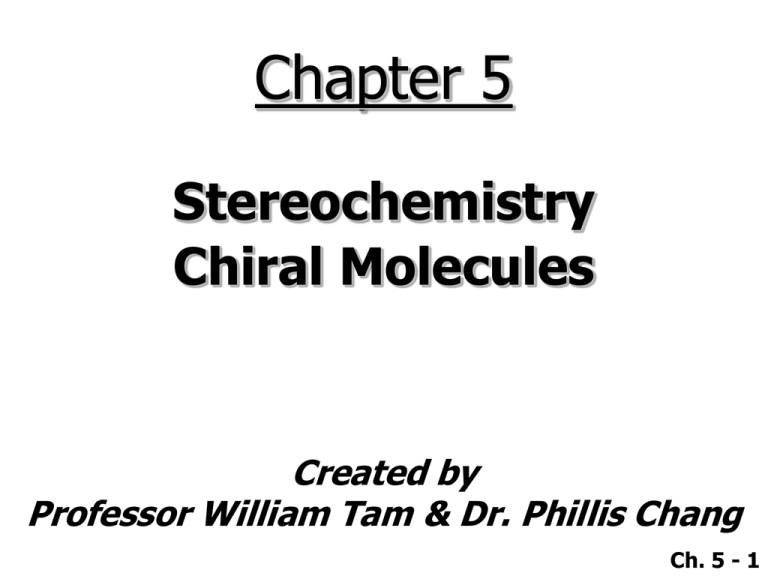
Chapter 5
Stereochemistry
Chiral Molecules
Created by
Professor William Tam & Dr. Phillis Chang
Ch. 5 - 1
About The Authors
These Powerpoint Lecture Slides were created and prepared by Professor
William Tam and his wife Dr. Phillis Chang.
Professor William Tam received his B.Sc. at the University of Hong Kong in
1990 and his Ph.D. at the University of Toronto (Canada) in 1995. He was an
NSERC postdoctoral fellow at the Imperial College (UK) and at Harvard
University (USA). He joined the Department of Chemistry at the University of
Guelph (Ontario, Canada) in 1998 and is currently a Full Professor and
Associate Chair in the department. Professor Tam has received several awards
in research and teaching, and according to Essential Science Indicators, he is
currently ranked as the Top 1% most cited Chemists worldwide. He has
published four books and over 80 scientific papers in top international journals
such as J. Am. Chem. Soc., Angew. Chem., Org. Lett., and J. Org. Chem.
Dr. Phillis Chang received her B.Sc. at New York University (USA) in 1994, her
M.Sc. and Ph.D. in 1997 and 2001 at the University of Guelph (Canada). She
lives in Guelph with her husband, William, and their son, Matthew.
Ch. 5 - 2
1. Chirality & Stereochemistry
An object is achiral (not chiral) if the
object and its mirror image are
identical
Ch. 5 - 3
A chiral object is one that cannot be
superposed on its mirror image
Ch. 5 - 4
1A. The Biological Significance of
Chirality
Chiral molecules are molecules that
cannot be superimposable with their
mirror images
O
N
O
● One enantiomer
causes birth defects,
NH
O the other cures
morning sickness
O
Thalidomide
Ch. 5 - 5
HO
HO
NH
OMe
Tretoquinol
OMe
OMe
● One enantiomer is a bronchodilator, the
other inhibits platelet aggregation
Ch. 5 - 6
66% of all drugs in development are
chiral, 51% are being studied as a single
enantiomer
Of the $475 billion in world-wide sales of
formulated pharmaceutical products in
2008, $205 billion was attributable to
single enantiomer drugs
Ch. 5 - 7
2. Isomerisom: Constitutional
Isomers & Stereoisomers
2A. Constitutional Isomers
Isomers: different compounds that
have the same molecular formula
● Constitutional isomers: isomers
that have the same molecular
formula but different connectivity –
their atoms are connected in a
different order
Ch. 5 - 8
Examples
Molecular
Formula
C4H10
Constitutional
Isomers
and
Butane
2-Methylpropane
Cl
C3H7Cl
Cl
1-Chloropropane
and
2-Chloropropane
Ch. 5 - 9
Examples
Molecular
Formula
C2H6O
Constitutional
Isomers
CH3 O CH3
OH and
Ethanol
Methoxymethane
O
C4H8O2
OH and
Butanoic acid
OCH3
O
Methyl propanoate
Ch. 5 - 10
2B. Stereoisomers
Stereoisomers are NOT constitutional
isomers
Stereoisomers have their atoms
connected in the same sequence but
they differ in the arrangement of their
atoms in space. The consideration of
such spatial aspects of molecular
structure is called stereochemistry
Ch. 5 - 11
2C. Enantiomers & Diastereomers
Stereoisomers can be subdivided into
two general categories:
enantiomers & diasteromers
● Enantiomers – stereoisomers
whose molecules are
nonsuperposable mirror images of
each other
● Diastereomers – stereoisomers
whose molecules are not mirror
images of each other
Ch. 5 - 12
Geometrical isomers
(cis & trans isomers) are:
● Diastereomers
e.g.
Ph
Ph
and
Ph
(cis)
Cl
Ph
(trans)
Cl
Cl
H
H
Cl
and
H
H
(cis)
(trans)
Ch. 5 - 13
Subdivision of Isomers
Isomers
(different compounds with same
molecular formula)
Constitutional Isomers
(isomers whose atoms have a
different connectivity)
Stereoisomers
(isomers that have the same
connectivity but differ in spatial
arrangement of their atoms)
Enantiomers
(stereoisomers that are
nonsuperposable mirror
images of each other)
Diastereomers
(stereoisomers that are
NOT mirror images of
each other)
Ch. 5 - 14
3. Enantiomers and Chiral
Molecules
Enantiomers occur only with compounds
whose molecules are chiral
A chiral molecule is one that is NOT
superposable on its mirror image
The relationship between a chiral
molecule and its mirror image is one
that is enantiomeric. A chiral
molecule and its mirror image are said
to be enantiomers of each other
Ch. 5 - 15
OH
H
(I)
OH
(2-Butanol)
HO
H
(I) and (II) are
nonsuperposable
mirror images of
each other
(II)
Ch. 5 - 16
4. A Single Chirality Center
Causes a Molecule to Be Chiral
The most common type of chiral
compounds that we encounter are
molecules that contain a carbon atom
bonded to four different groups. Such
a carbon atom is called an asymmetric
carbon or a chiral center and is
usually designated with an asterisk (*)
Ch. 5 - 17
Cl
Me C* Et
H
H
Cl
Cl
H
Me
Et
(III)
Et
Me
(IV)
mirror
(III) and (IV) are nonsuperposable
mirror images of each other
Ch. 5 - 18
Cl
Me C Me
H
H
Cl
Me
Cl
Me
Me
(V)
H
Me
(VI)
mirror
(V) and (VI) are superposable
⇒ not enantiomers ⇒ achiral
Ch. 5 - 19
4A. Tetrahedral vs. Trigonal
Stereogenic Centers
Chirality centers are tetrahedral
stereogenic centers
H
Tetrahedral
stereogenic
center
⇒ chiral
HO
OH
H
Et * Me
(B)
Me * Et
(A)
mirror
(A) & (B) are
enantiomers
Ch. 5 - 20
Cis and trans alkene isomers contain
trigonal stereogenic centers
Trigonal
stereogenic
center
⇒ achiral
Ph
H
H
Ph
H
Ph
Ph
H
(D)
(C)
mirror
(C) & (D) are identical
Ch. 5 - 21
4A. Tetrahedral vs. Trigonal
Stereogenic Centers
Chirality centers are tetrahedral
stereogenic centers
Cis and trans alkene isomers contain
trigonal stereogenic centers
Ch. 5 - 22
5. More about the Biological
Importance of Chirality
(+)-Limonene
(limonene enantiomer
found in oranges)
(-)-Limonene
(limonene enantiomer
found in lemons)
Ch. 5 - 23
Thalidomide
The activity of drugs containing
chirality centers can vary between
enantiomers, sometimes with serious
or even tragic consequences
For several years before 1963
thalidomide was used to alleviate the
symptoms of morning sickness in
pregnant women
Ch. 5 - 24
In 1963 it was discovered that thalidomide
(sold as a mixture of both enantiomers) was
the cause of horrible birth defects in many
children born subsequent to the use of the
drug
O
N
O
O
NH
O
O
Thalidomide
(cures morning sickness)
N
O
NH
O
O
enantiomer of
Thalidomide
(causes birth defects)
Ch. 5 - 25
6. How to Test for Chirality:
Planes of Symmetry
A molecule will not be chiral if it
possesses a plane of symmetry
A plane of symmetry (mirror plane) is an
imaginary plane that bisects a molecule
such that the two halves of the molecule
are mirror images of each other
All molecules with a plane of symmetry
in their most symmetric conformation
are achiral
Ch. 5 - 26
Plane of symmetry
Cl
Me
Me
H
achiral
Cl
Me
Et
H
No plane of symmetry
chiral
Ch. 5 - 27
7.
Naming Enantiomers: R,S-System
Recall:
OH
H
(I)
OH
HO
H
(II)
Using only the IUPAC naming that we have
learned so far, these two enantiomers will
have the same name:
● 2-Butanol
This is undesirable because each compound
must have its own distinct name
Ch. 5 - 28
7A. How to Assign (R) and (S)
Configurations
Rule 1
● Assign priorities to the four different
groups on the stereocenter from
highest to lowest (priority bases on
atomic number, the higher the
atomic number, the higher the
priority)
Ch. 5 - 29
Rule 2
● When a priority cannot be assigned
on the basis of the atomic number
of the atoms that are directly
attached to the chirality center, then
the next set of atoms in the
unassigned groups is examined.
This process is continued until a
decision can be made.
Ch. 5 - 30
Rule 3
● Visualize the molecule so that the
lowest priority group is directed
away from you, then trace a path
from highest to lowest priority. If
the path is a clockwise motion, then
the configuration at the asymmetric
carbon is (R). If the path is a
counter-clockwise motion, then the
configuration is (S)
Ch. 5 - 31
Example
①
Step 1:
② or ③
H
O
H
C
①
Step 2:
HO
H3C
④
C
H
O
③
(2-Butanol)
② or ③
④
C ② CH
3
C
H2
(H, H, H)
(C, H, H)
Ch. 5 - 32
①
④
③
OH
OH
Me
Et
②
Et
Me
OH
OH
Me
H
HO
Et
Me
H
Et
= H
Arrows are clockwise
Et
Me
(R)-2-Butanol
Ch. 5 - 33
Other examples
①
Cl
④
③
H
HO
Counterclockwise
Cl
CH3
HO
CH3
(S)
②
②
OCH3
④
H3C
① Br
③
CH2CH3
OCH3
Br
Clockwise
(R)
CH2CH3
Ch. 5 - 34
Other examples
● Rotate C–Cl bond such that H is pointed
to the back
②
Cl
Cl
④
Br
HO
H
③
H
OH
① Br
Cl
Br
Clockwise
OH
(R)
Ch. 5 - 35
Other examples
● Rotate C–CH3 bond such that H is
pointed to the back
②
H
I
H3C
OCH3
④
OCH3
①
H
I
H3C ③
Counter-clockwise
H 3C
OCH3
I
(S)
Ch. 5 - 36
Rule 4
● For groups containing double or
triple bonds, assign priorities as if
both atoms were duplicated or
triplicated
e.g.
C O
as
C O
O C
C C
as
C C
C C
C C
as
C C
C C
C C
Ch. 5 - 37
Example
③
④
CH3
②
H
HO ①
Compare
CH3
&
CH CH2
Thus,
CH3
(S)
CH=CH2
CH CH2 :
equivalent to
H H
C C H
C C
(H, H, H)
CH CH2 (C, C, H)
Ch. 5 - 38
Other examples
②
(R)
OH
④
H
③ CH3
Cl ① O
③
H 2C
④
OH
H
② CH3
① Cl
O
(S)
② C (O, O, C)
③
C (O, H, H)
Ch. 5 - 39
8.
Properties of Enantiomers:
Optical Activity
Enantiomers
● Mirror images that are not
superposable
H
Cl
H3CH2C
H
*
*
CH3
H3C
mirror
Cl
CH2CH3
Ch. 5 - 40
Enantiomers have identical physical
properties (e.g. melting point, boiling
point, refractive index, solubility etc.)
Compound
bp (oC)
(R)-2-Butanol
99.5
(S)-2-Butanol
99.5
mp (oC)
(+)-(R,R)-Tartaric Acid
168 – 170
(–)-(S,S)-Tartaric Acid
168 – 170
(+/–)-Tartaric Acid
210 – 212
Ch. 5 - 41
Enantiomers
● Have the same chemical properties
(except reaction/interactions with
chiral substances)
● Show different behavior only when
they interact with other chiral
substances
● Turn plane-polarized light on
opposite direction
Ch. 5 - 42
Optical activity
● The property possessed by chiral
substances of rotating the plane of
polarization of plane-polarized light
Ch. 5 - 43
8A. Plane-Polarized Light
The electric field (like the magnetic
field) of light is oscillating in all
possible planes
When this light passes through a
polarizer (Polaroid lens), we get planepolarized light (oscillating in only one
plane)
Polaroid
lens
Ch. 5 - 44
8B. The Polarimeter
A device for measuring the optical
activity of a chiral compound
a =observed
optical rotation
Ch. 5 - 45
8C. Specific Rotation
observed
rotation
temperature
25
[a]D =
wavelength
of light
(e.g. D-line
of Na lamp,
l=589.6 nm)
c
a
x ℓ
concentration length of cell
of sample
in dm
solution
(1 dm = 10 cm)
in g/mL
Ch. 5 - 46
The value of a depends on the
particular experiment (since there are
different concentrations with each run)
● But specific rotation [a] should be
the same regardless of the
concentration
Ch. 5 - 47
Two enantiomers should have the
same value of specific rotation, but the
signs are opposite
CH3
CH3
*
H
HO
25
*
CH2CH3
[a] = + 13.5
D
o
H3CH2C
25
mirror
H
OH
[a] = 13.5
o
D
Ch. 5 - 48
9.
The Origin of Optical Activity
Ch. 5 - 49
Ch. 5 - 50
Two circularlypolarized beams
counter-rotating at
the same velocity
(in phase), and
their vector sum
Two circularly-polarized
beams counter-rotating
at different velocities,
such as after interaction
with a chiral molecule,
and their vector sum
Ch. 5 - 51
9A. Racemic Forms
An equimolar mixture of two
enantiomers is called a racemic mixture
(or racemate or racemic form)
A racemic mixture causes no net
rotation of plane-polarized light
equal & opposite
rotation by the
enantiomer
rotation
H
CH3
OH
C2H5
(R)-2-Butanol
H 3C
H
HO
C2H 5
(S)-2-Butanol
(if present)
Ch. 5 - 52
9B. Racemic Forms and Enantiomeric
Excess
A sample of an optically active
substance that consists of a single
enantiomer is said to be
enantiomerically pure or to have an
enantiomeric excess of 100%
Ch. 5 - 53
An enantiomerically pure sample of (S)-(+)2-butanol shows a specific rotation of
+13.52
25
[a]D
= +13.52
A sample of (S)-(+)-2-butanol that contains
less than an equimolar amount of (R)-(–)-2butanol will show a specific rotation that is
less than 13.52 but greater than zero
Such a sample is said to have an
enantiomeric excess less than 100%
Ch. 5 - 54
Enantiomeric excess (ee)
● Also known as the optical purity
% enantiomeric
=
excess
mole of one
enantiomer
moles of other
enantiomer
total moles of both enantiomers
x 100
● Can be calculated from optical
rotations
% enantiomeric
=
excess *
observed specific rotation
specific rotation of the
pure enantiomers
x 100
Ch. 5 - 55
Example
● A mixture of the 2-butanol
enantiomers showed a specific
rotation of +6.76. The
enantiomeric excess of the (S)-(+)2-butanol is 50%
% enantiomeric
=
excess *
+6.76
+13.52
x 100 = 50%
Ch. 5 - 56
10. The Synthesis of Chiral Molecules
10A.
Racemic Forms
CH3CH2CCH3 + H H
(
)-CH3CH2CHCH3
OH
O
Butanone
(achiral
molecules)
Ni
Hydrogen
(achiral
molecules)
(
)-2-Butanol
(chiral
molecules; but
50:50 mixture
(R) & (S))
Ch. 5 - 57
Ch. 5 - 58
10B.
Stereoselective Syntheses
Stereoselective reactions are reactions
that lead to a preferential formation of one
stereoisomer over other stereoisomers that
could possibly be formed
● enantioselective – if a reaction
produces preferentially one enantiomer
over its mirror image
● diastereoselective – if a reaction
leads preferentially to one diastereomer
over others that are possible
Ch. 5 - 59
O
O
+
OEt
F
racemate (
)
O
OEt
F
racemate (
)
H , H2O
heat
OH + EtOH
F
racemate (
)
O
H2O
lipase
OH
F
()
(> 69% ee)
O
+
OEt + EtOH
F
(+)
(> 99% ee)
Ch. 5 - 60
11. Chiral Drugs
Of the $475 billion in world-wide sales of
formulated pharmaceutical products in
2008, $205 billion was attributable to single
enantiomer drugs
NC
HO
O
F
NMe2
Escitalpram
(anti-depressant )
HO
NH3
CO2
H
L-DOPA
(treatment for Parkinson's)
Ch. 5 - 61
Naproxen
(anti-inflammatory drug)
CO2H
CH3
MeO
NaO2C
S
Cl
CH3
HO
CH3
N
Singulair
(asthma and allergy treatment)
Ch. 5 - 62
12. Molecules with More than One
Chirality Center
Diastereomers
● Stereoisomers that are not
enantiomers
● Unlike enantiomers, diastereomers
usually have substantially different
chemical and physical properties
Ch. 5 - 63
Br
Cl C H
HO C H
CH3
Br
H C Cl
OH
H C
CH3
(II)
Br
C H
Cl
(III)
CH3 C H
HO
Br
H C Cl
H C CH3
OH
(IV)
(I)
Note: In compounds with n tetrahedral
stereocenters, the maximum number of
stereoisomers is 2n.
Ch. 5 - 64
Br
Cl C H
HO C H
CH3
Br
H C Cl
OH
H C
CH3
(II)
Br
C H
Cl
(III)
CH3 C H
HO
Br
H C Cl
H C CH3
OH
(IV)
(I)
(I) & (II) are enantiomers to each other
(III) & (IV) are enantiomers to each
other
Ch. 5 - 65
Br
Cl C H
HO C H
CH3
Br
H C Cl
OH
H C
CH3
(II)
Br
C H
Cl
(III)
CH3 C H
HO
Br
H C Cl
H C CH3
OH
(IV)
(I)
Diastereomers to each other:
● (I) & (III), (I) & (IV), (II) & (III),
(II) & (IV)
Ch. 5 - 66
12A.
Meso Compounds
Compounds with two stereocenters do
not always have four stereoisomers
(22 = 4) since some molecules are
achiral (not chiral), even though they
contain stereocenters
For example, 2,3-dichlorobutane has
two stereocenters, but only has 3
stereoisomers (not 4)
Ch. 5 - 67
H
(I)
CH3 C Br
CH3 C Br
H
H
C Br
CH
3
(III)
H C Br
CH3
Br
Br
Br
Br
H
C CH
3 (II)
C CH3
H
H
C CH
3 (IV)
C H
CH3
Note: (III) contains a plane of symmetry,
is a meso compound, and is achiral ([a]
= 0o).
Ch. 5 - 68
H
(I)
CH3 C Br
CH3 C Br
H
H
C Br
CH
3
(III)
H C Br
CH3
Br
Br
Br
Br
H
C CH
3 (II)
C CH3
H
H
C CH
3 (IV)
C H
CH3
(I) & (II) are enantiomers to each
other and chiral
(III) & (IV) are identical and achiral
Ch. 5 - 69
H
(I)
CH3 C Br
CH3 C Br
H
H
C Br
CH
3
(III)
H C Br
CH3
Br
Br
Br
Br
H
C CH
3 (II)
C CH3
H
H
C CH
3 (IV)
C H
CH3
(I) & (III), (II) & (III) are diastereomers
Only 3 stereoisomers:
● (I) & (II) {enantiomers}, (III) {meso}
Ch. 5 - 70
12B. How to Name Compounds with
More than One Chirality Center
a
2,3-Dibromobutane
H
Br
Br
2
① Br
③
C2: (R) configuration
C1
H
3
4
1
● Look through C2–Ha bond
b
a④
H
2
②
C3
(H, H, H) (Br, C, H)
Ch. 5 - 71
● Look through C3–Hb bond
Br
a
H
Br
2
1
b
①
4
③
H
3
CH3
CH3
b
H
Br
C4
3
④
②
C2
(H, H, H) (Br, C, H)
C3: (R) configuration
● Full name:
(2R, 3R)-2,3-Dibromobutane
Ch. 5 - 72
13. Fischer Projection Formulas
13A. How To Draw and Use Fischer
Projections
Fischer
Projection
HO
H3C
Et
Br
COOH
Ph
COOH
COOH
Br
Ph
Br
Ph
Et
OH
Et
OH
CH3
CH3
Ch. 5 - 73
H
Me
COOH
Ph
H
Me OH
H
H
Ph
OH
COOH
COOH
HO
Fischer
Me
Projection
Ph
COOH
H
HO
H
H
Me
H
Ph
Ch. 5 - 74
Cl
H
H
H3C
Cl
H
Cl
CH3
H3C
(I)
(2S, 3S)-Dichlorobutane
H
CH3
(II)
(2R, 3R)-Dichlorobutane
CH3
CH3
H
Cl
Cl
H
CH3
Cl
enantiomers
mirror
Cl
H
H
Cl
CH3
(I) and (II) are both chiral and they are
enantiomers with each other
Ch. 5 - 75
Cl
H 3C
H
H
CH3
Cl
CH3
(III)
(2S, 3R)-Dichlorobutane
H
Cl
H
Cl
CH3
Plane of
symmetry
(III) is achiral (a meso compound)
(III) and (I) are diastereomers to each
other
Ch. 5 - 76
14. Stereoisomerism of Cyclic
Compounds
a meso compound
achiral
mirror
H
Me
H
Me
Me
Me
Me
H
Me
H
H
H
enantiomers
Plane of
symmetry
Ch. 5 - 77
14A. Cyclohexane Derivatives
1,4-Dimethylcyclohexane
Me
Plane of
symmetry
Me
Me
Me
H
Me
Me
• Both cis- & trans1,4-dimethylcyclohexanes are
achiral and
optically inactive
H
H
cis-1,4-dimethyl
cyclohexane
Me
• The cis & trans
Me forms are
H
trans-1,4-dimethyl
cyclohexane
diastereomers
Ch. 5 - 78
1,3-Dimethylcyclohexane
Plane of
symmetry
Me
*
*
Me
cis-1,3-dimethyl
cyclohexane
Me
Me
H
H
(meso)
● cis-1,3-Dimethylcyclohexane has a
plane of symmetry and is a meso
compound
Ch. 5 - 79
1,3-Dimethylcyclohexane
NO plane of symmetry
Me
* *
Me
trans-1,3-dimethyl
cyclohexane
Me
H
Me
Me
H
H
H
Me
enantiomers
● trans-1,3-Dimethylcyclohexane
exists as a pair of enantiomers
Ch. 5 - 80
1,3-Dimethylcyclohexane
● Has two chirality centers but only
three stereoisomers
cis-1,3-dimethyl
cyclohexane
Me
H
H
Me
(meso)
trans-1,3-dimethyl
cyclohexane
Me
H
Me
Me
H
H
H
Me
enantiomers
Ch. 5 - 81
1,2-Dimethylcyclohexane
mirror
H
H
Me
Me
Me
Me
H
H
enantiomers
● trans-1,2-Dimethylcyclohexane
exists as a pair of enantiomers
Ch. 5 - 82
1,2-Dimethylcyclohexane
● With cis-1,2-dimethylcyclohexane
the situation is quite complicated
mirror
Me
H
Me
(I)
H
Me
H
Me
H
(II)
● (I) and (II) are enantiomers to each
other
Ch. 5 - 83
● However, (II) can rapidly be
interconverted to (III) by a ring flip
Me
2'
1'
(I)
mirror
H
Me
Me
H 2
Me
H
1
(II)
H
Me
Me
2
H
1
H
(III)
Ch. 5 - 84
● Rotation of (III) along the vertical
axis gives (I)
Me
2'
1'
(I)
H
Me
Me
H 2
Me
H
C1 of (II) and (III)
become C2’ of (I) &
C2 of (II) and (III)
become C1’ of (I)
1
(II)
H
Me
Me
2
H
1
(III)
H
Ch. 5 - 85
Me
2'
1'
(I)
H
Me
Me
H 2
Me
H
Although (I) and (II)
are enantiomers to
each other, they can
interconvert rapidly
(I) and (II) are
1
(II)
H
Me
Me
2
H
1
(III)
H
achiral
Ch. 5 - 86
15. Relating Configurations through
Reactions in Which No Bonds to
the Chirality Center Are Broken
If a reaction takes place in a way
so that no bonds to the chirality
center are broken, the product will
of necessity have the same general
configuration of groups around the
chirality center as the reactant
Ch. 5 - 87
Same configuration
O
Me H
Me
Ph
H
OH
H
H
Me H
NaBH4
MeOH
Me
NaCN
H
Br
DMSO
Ph
Same configuration
H
CN
Ch. 5 - 88
15A. Relative and Absolute Configurations
Chirality centers in different molecules have
the same relative configuration if they
share three groups in common and if these
groups with the central carbon can be
superposed in a pyramidal arrangement
Y
A
X
A
B
II
C
B
I
C
The chirality centers
in I and II have the
same relative
configuration. Their
common groups and
central carbon can
be superposed. Ch. 5 - 89
The absolute configuration of a chirality
center is its (R) or (S) designation, which
can only be specified by knowledge of the
actual arrangement of groups in space at
the chirality center
(R)-2-Butanol
(S)-2-Butanol
H OH
HO H
enantiomers
Ch. 5 - 90
16. Separation of Enantiomers:
Resolution
Resolution – separation of two enantiomers
O
e.g.
OH
R * R'
(racemic)
O
O
Cl
O Me
P h C F3
(Mosher acid
chloride)
R
R'
O Me
C F3
Ph
(1
O
O
+
R
:
R'
O Me
C F3
Ph
1)
diastereomers
usually separable
either by flash column
chromatography or
recrystallization etc.
Ch. 5 - 91
Kinetic Resolution
OH
OH
R
*
R1
R2
(racemic)
R
*
OH
R1
R2
+
R
*
R1
O R2
● One enantiomer reacts “fast” and
another enantiomer reacts “slow”
Ch. 5 - 92
e.g.
Me3Si
t
*
i
BuOOH, Ti(O Pr)4
OH
HO
COOEt
HO
COOEt
(-)-DET:
(D)-(-)-Diethyl Tartrate
R'
OH
C5H11
C5H11
43%
(99%ee)
42%
(99%ee)
Me3Si
O
OH +
(-)-DET
C5H11
(racemic)
Me3Si
Me3Si
Me3Si
S OH
H
* stop reaction at 50%
* maximum yield = 50%
H
R OH
R'
Ch. 5 - 93
17. Compounds with Chirality
Centers Other than Carbon
R4
R1
R3
Si
H
R2
R1
R4
R1
R2
Ge
R2
R2
R3
N
R3
X
R1
S
O
Ch. 5 - 94
18. Chiral Molecules That Do Not
Possess a Chirality Center
P(Ph)2
(Ph)2P
P(Ph)2
(Ph)2P
(S)-BINAP
(R)-BINAP
enantiomers
Ch. 5 - 95
mirror
H
C
Cl
C
C
H
H
Cl
Cl
H
C
C
C
Cl
enantiomers
Ch. 5 - 96
END OF CHAPTER 5
Ch. 5 - 97
